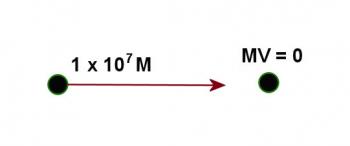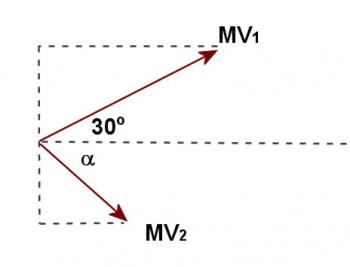Elastic Collisions
Reference > Science > Physics > Study Guide > Unit 5: MomentumIn working with collisions please keep the following in mind: Momentum is always conserved. If you find a situation where it is not then you do not have a closed system. Some object which you are ignoring is carrying away some momentum. Kinetic energy is conserved only in elastic collisions. If objects stick together, are permanently deformed or if heat or some other form of energy is released in a collision, the collision is not elastic. Kinetic energy can remain the same or decrease. It can never increase in a simple collision. The only situation in which kinetic energy will increase is when there is an outside source of energy involved such as some kind of explosion, and even in these cases momentum will still be conserved. It is possible to determine the degree of elasticity of a collision by determining the amount of kinetic energy lost during the collision.
When solving problems involving elastic collisions you must make momentum be conserved in all three directions. This will provide you with 3 equations if the objects involved move in three dimensional space. In addition kinetic energy, a scalar, is also conserved giving you one additional equation. Thus it should be possible to solve for as many as four variables. However, in practice the solution of these equations can be very tedious since they will involve trigonometric relationships. Therefore you will rarely be asked to complete the solution of a three dimensional elastic collision problem. However, you should be able to draw the vector diagrams and set up the necessary equations. Problem 5.6 demonstrates a three dimensional elastic collision problem.
Sample Problem #1
A ball of mass 200 g and with a speed of 50Sample Solution #1
Before solving the set of equations notice that one of the equations is a quadratic so you should expect to obtain two sets of solutions. Be sure not to lose one of them.
When solved the following roots are obtained:
VA = â0.3m/sec and VB = 0.4m/sec
The first set of roots corresponds to the rather uninteresting case where the incoming object misses the stationary object so both objects continue moving as they were. The second set of answers corresponds to the case where the moving ball hits the stationary ball. You will note that the speed of the ball A comes out negative indicating that the ball rebounds from the larger ball. In general, for elastic head on collisions, if the balls are equal in mass the first will stop and the second will carry away all the initial momentum. If the first is lighter than the stationary ball it will rebound, and if it is heavier than the second it will keep going although with reduced speed and the second will move in the same direction at a higher speed.
Sample Problem #2
In a proton collision with another proton at rest, the first had a velocity of 1 x 107- What was its speed after the collision?
- At what angle and with what speed did the other proton go off?
Sample Solution #2
Examine the diagrams below carefully. Figure 5.3.1 shows the momenta of the two protons before the collision and figure 5.3.2 shows the momenta after. In constructing the diagrams the direction of motion of the original proton was chosen as the Xâaxis for convenience.

Figure 5.3.1

Figure 5.3.2
First break the momentum vectors into x and y components. Then write two equations, one for the x-momentum and the other for the y-momentum. These follow:
x-comp
y-comp
The student will be forgiven if he/she absolutely refuses to work out these equations. However, for the adventuresome student the answers are:
V1 = 8.7 x 106V2 = 5.0 x 106
α = 60º
Questions
 Conservation of Momentum
Conservation of Momentum Unit Index
Unit Index
